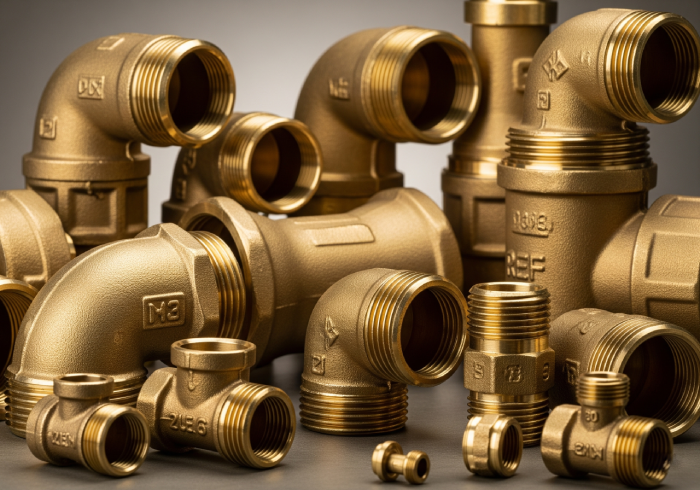When it comes to sourcing Brass Fittings for your organization, making the right choice can mean the difference between reliable system performance and costly downtime. As a purchasing manager, you need components that not only fit your technical specifications but also align with budget, compliance, and long‑term maintenance goals. This guide walks you through the critical factors to consider when selecting Brass Fittings, ensuring you get the best value and performance for your projects.
1. Understand Your Application Requirements
Before evaluating products, clearly define the system’s needs:
-
Fluid or Gas Medium: Water, steam, compressed air, oil, chemicals.
-
Operating Pressure & Temperature: Low‑pressure plumbing vs. high‑pressure hydraulic circuits.
-
Environmental Conditions: Indoor, outdoor, corrosive environments (marine, chemical plants).
-
Connection Type: BSP, NPT, ISO metric, compression, soldered or threaded.
Knowing these parameters helps narrow your options to Brass Fittings engineered for those exact conditions.
2. Material Grades and Alloy Composition
Not all brass alloys are created equal. Common grades include:
-
CZ121 / C36000: Excellent machinability and moderate strength—ideal for general plumbing and instrumentation.
-
CW617N / C37700: Lead‑free options for potable‑water and food‑grade applications.
-
CuSn6 / C51000 (Tin Bronze): Enhanced corrosion resistance for marine or chemical exposure.
Always verify alloy certification (e.g., ASTM, BS EN, IS) to ensure the raw material meets your industry standards and health‑safety requirements.
3. Compliance with International Standards
Purchasing managers must confirm fittings comply with relevant standards:
-
ISO 9001: Quality‑management system certification of the manufacturer.
-
ASTM B62 / EN 1254: Sand‑casting standards for parts produced via molding.
-
BS 2874 / IS 778: Forged and turned‑brass specifications.
-
NSF/ANSI 61: For drinking‑water system components.
Specifying standards in your purchase order prevents mismatches and ensures traceability.
4. Connection Styles & Thread Types
The wrong thread type or seal face can lead to leaks and rework:
| Connection Style | Typical Use |
|---|---|
| Threaded (BSP/NPT) | General plumbing, HVAC systems |
| Compression | Instrumentation, gas lines |
| Flared | High‑pressure hydraulic and gas applications |
| Soldered/Brazed | HVAC, refrigeration, aesthetic fixtures |
Always confirm thread dimensions and sealing method. When possible, request Go/No‑Go gauge reports from the supplier for full confidence.
5. Surface Finish & Coating
Surface treatments improve longevity and appearance:
-
Natural Machined Finish: Standard for indoor and non‑corrosive uses.
-
Nickel or Chrome Plating: Enhanced corrosion resistance and shine for exposed installations.
-
Electro‑Tin Coating: Food‑grade applications and improved solderability.
Select a finish aligned with both functional and aesthetic requirements.
6. Pressure Rating & Temperature Range
Ensure the Brass Fittings you choose can handle your system’s extremes:
| Parameter | Typical Brass Rating |
|---|---|
| Pressure | Up to 16 bar (standard); up to 40 bar (high‑pressure series) |
| Temperature | –20 °C to +120 °C; specialized alloys up to +200 °C |
For critical systems—such as steam or high‑pressure hydraulics—opt for fittings explicitly rated for those conditions.
7. Supplier Quality Assurance
Partnering with a reliable manufacturer reduces risk:
-
In‑house Testing: CMM, pressure testing, leak testing, hardness testing.
-
Documentation: Material Test Certificates (MTC), certificate of origin, dimensional inspection reports.
-
Batch Traceability: Lot numbers on packaging, serialized components for critical applications.
A supplier with robust SPC/SQC systems and ISO certification will consistently meet your specifications.
8. Total Cost of Ownership (TCO)
Beyond unit price, factor in:
-
Installation Time: Quick‑connect or push‑fit fittings can reduce labor costs.
-
Maintenance Intervals: Corrosion‑resistant alloys extend service life and reduce downtime.
-
Replacement Costs: Standardized fittings across facilities simplify spares management.
A slightly higher upfront investment in premium Brass Fittings often pays off through lower maintenance and replacement expenses.
9. Customization & Lead Times
If your project demands non‑standard sizes or special configurations:
-
MOQ Flexibility: Look for suppliers offering low or no minimums for prototypes.
-
Custom Machining: CNC turning, forging, or casting capabilities for bespoke designs.
-
Turnaround Time: Standard 4–6 weeks vs. expedited slots—confirm lead times before ordering.
Discuss your project timeline early to align production schedules and avoid last‑minute rush charges.
10. Sustainability & Environmental Considerations
Many organizations now require eco‑friendly practices:
-
Lead‑Free Alloys: Compliance with EU’s RoHS and U.S. Safe Drinking Water Act.
-
Recyclability: Brass is highly recyclable with minimal material loss.
-
Energy‑Efficient Production: Suppliers using in‑house rod plants and optimized machining cut carbon footprints.
Including sustainability criteria in your procurement strategy enhances corporate responsibility goals.
Conclusion & Next Steps
Choosing the right Brass Fittings involves a balance of technical performance, regulatory compliance, cost efficiency, and supplier reliability. By following the steps above—from defining application needs to evaluating supplier quality systems—you’ll secure fittings that deliver long‑term value and dependable operation.
Ready to streamline your brass fittings procurement?
📞 Call us at +91‑22‑43449300
📧 Email sales@brass-copper-parts.com
💬 Chat on WhatsApp for an immediate quote and technical consultation.
Partner with Brass & Copper Parts—Precision Made in Jamnagar.


